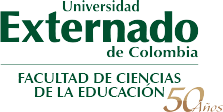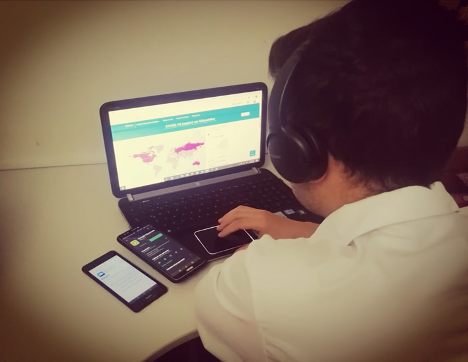25 de mayo de 2020
Education in confinement times: A sense of uncertainty and hope
Romario Aranda Rodríguez
The Colombian National Government declared a mandatory preventive isolation that entailed the temporal nationwide schools closure. Reflecting upon the educational disruption caused by the COVID–19 pandemic, some particular questions arise in terms of the teaching and learning impact in Colombia. Which are the challenges for the educational system? Are teachers ready to move from a traditional face-to-face classroom mode to a virtual one? How is the student population affected? How possible is it to ensure learning continuity?
Overcoming the current health emergency around the world remains an unknown matter. On the subject of this health emergency impact on education, the UNESCO Institute for Statistics data (2020) has stated that there are 1,576,021,818 students from all educational levels are affected by school closures. UNESCO also added that the specific number of affected learners in Colombia exceeds 12 million. Under such circumstances, this situation concerns the entire educational system.
Due to the urgent need for adopting suitable measures, school closures was a response to diminish the spread of COVID-19. However, according to Viner et al. (2020) there are “adverse effects of school closure, including economic harms to working parents (…) loss of education, harms to child welfare particularly among the most vulnerable” (p. 2). Taking into account the aforementioned effects and based on my nearly experience, I have become aware that school closures require the development of proposals to respond to new challenges. These proposals may include (a) an inclusive and flexible education system, where government’s participation attempts to cover the areas where there is no internet connectivity for ensuring distance learning; (b) reorganizing the academic timeline and creating efficient institutional communication channels to support children’ needs, facilitating and providing real interaction contexts; (c) turning teaching and curricular environments into virtual, providing support and training in digital and ICT skills for teachers.
On one hand, the current panorama suggests that teachers’ bodies are confined, but teachers’ minds are active. In light of this, it is paramount thinking critically about human condition, since they are actors that exert a political role by communicating, learning, knowing, participating, teaching, and doing collaborative actions. To this extent, Kincheloe, McLaren and Steinberg (2011) asserted that “critical scholar teachers research their own professional practice. With empowered scholar teachers prowling the schools, things begin to change” (p. 166). To deal with this role, teachers found themselves managing virtual classrooms from one day to another, so it is advisable to consider this panorama as an opportunity to become more empowered and innovative.
Furthermore, while some teachers are supportive to each other, others may experience increasing levels of anxiety, extra pressure, and stressful situations dealing with the use of technological and digital resources. I coincide with Núñez, Téllez and Castellanos (2017a) when they highlight that “increasing their awareness of their role as educators, teachers’ voices can be heard and eventually increase other teachers’ awareness” (Núñez, Téllez & Castellanos, 2017a, p. 26). Hence, teachers’ awareness about the panorama and their role not only entails training and knowledge, but also mutual support and wellbeing in terms of their socio-emotional needs.
On the other hand, Colombian students from all educational levels face the challenges of a system where contextual needs have been given in a face-to-face classroom mode. The aforementioned mode requires an educational strategy reform to engage students on a virtual classroom mode. I fully agree with Giroux and Filippakou’s (2020) words when they claim that “educators and others should attempt to create the conditions that give students the opportunity to become critical and engaged citizens who have the knowledge and courage to struggle” (p. 1). With this in mind, remains the necessity of attending students bearing in mind the challenge of an education that requires technological support and the participation of educational community members. Hence, I consider that nothing can replace what schools bring to students concerning their active involvement in society’s reality.
Acknowledging that teachers’ support through technology and students’ involvement are key elements for ensuring learning continuity, many countries have launched national learning platforms, joining the initiative to facilitate teaching and learning processes. The Colombian Ministry of Education (MEN, 2020) drew attention to launch measures to guarantee students’ academic process at home. These measures include the broadcasting of educational content for children and youth called “3, 2, 1 Edu-Acción”, and an online platform called “Colombia Aprende” to support teachers, families, and students. Despite the fact that online learning platforms are suitable to be used as educational tools, there are other considerations that legitimate its use. For instance, the school administrators, teachers, parents and students’ communication needs to be addressed through these.
Summing up, the efforts adopted to endure the current health emergency and the resultant effects in the education system are historical, not only in Colombia, but also around the whole world. By the same token, the decisions taken by the government involve a significant effort on the part of teachers and families; first, by adapting teaching and learning methodologies, content, and resources into digital; second, by responding to the economic and academic demands of schools’ curricula; finally, by providing all education levels and areas with relevant conditions regarding learning and technological support.
This reflection intends to acknowledge the critical role teachers play when adapting to the new conditions shaping the educational system. This is a situation that causes uncertainty, awakens a sense of educational hope, and leads to many evincing questions and unpredictable answers.
__________________________
References
Giroux, H., & Filippakou, O. (2020). A Time for Hope in Dark Times. Retrieved from https://doi.org/10.3390/rel11030113
Kincheloe, J. L., Mclaren, P., & Steinberg, S. R. (2011). Critical pedagogy and qualitative research. In N. K. Denzin & Y. S. Lincoln (Eds.), The SAGE Handbook of Qualitative Research (4th ed) (pp. 163-177). Thousand Oaks, CA: Sage.
MEN. (2020). Estudiantes De Colegios Y Universidades Del País Continuarán En Aislamiento Preventivo Obligatorio Hasta El 31 De Mayo: Ministra De Educación – Ministerio De Educación Nacional De Colombia. [online]. Retrieved from https://www.mineducacion.gov.co/portal/salaprensa/Noticias/395617:Estudiantes-de-colegios-y-universidades-del-pais-continuaran-en-Aislamiento-Preventivo-Obligatorio-hasta-el-31-de-mayo-Ministra-de-Educacion
Núñez, A., Téllez, M., & Castellanos, J. (2017a). Materials development for teachers’ professional growth. In A. Núñez, M. Téllez, & J. Castellanos (Ed.). Teacher research on English didactic issues (pp. 19-68). Bogotá, Colombia: Departamento de Publicaciones Universidad Externado de Colombia.
UNESCO. (2020). COVID-19 Educational Disruption and Response. [online]. Retrieved from https://en.unesco.org/covid19/educationresponse
Viner, R. M., Russell, S. J., Croker, H., Packer, J., Ward, J., Stansfield, C., Mytton, O., Bonell, C., & Booy, R. (2020). School closure and management practices during coronavirus outbreaks including COVID-19: a rapid systematic review. The Lancet Child & Adolescent Health. Retrieved from https://www.thelancet.com/journals/lanchi/article/PIIS2352-4642(20)30095-X/fulltext


